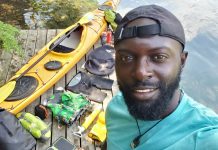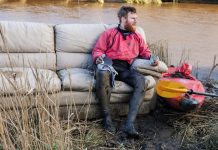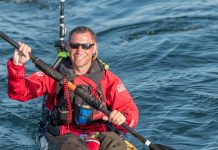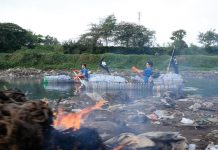On October 15, Traci Lynn Martin became the first person to circumnavigate North America’s three largest lakes in one season.
It was the 221st day of Martin’s controversial expedition, a trip that has been a source of much debate in the sea kayaking community. The original goal of the trip was to beat Freya Hoffmeister’s unofficial world record of longest solo sea kayak trip, made when Hoffmeister paddled 8,570 miles unassisted while circumnavigating Australia in 2009.
After unexpectedly frequent flares from rheumatoid arthritis, a chronic illness causing Martin extreme joint pain, she scaled back her plans. She decided instead to shoot for breaking the record of longest journey by surf ski, her craft of choice, currently held by Gerhard Moolman at 3,822 miles.
Martin’s background is in surf ski racing, which explains her unconventional choice of vessel for a multi-month expedition with major open water crossings. In fact, Martin’s original route had her circumnavigating all five Great Lakes and passing Prince Edward Island before paddling down the coast of Nova Scotia and Maine.
This is Martin’s first major expedition. At home in Kansas City she works as a neonatal nurse. She’s quick to admit to unwisely approaching this expedition with a racer’s mentality, having planned to simply power through challenges to get to the finish line.
In March, after two distress calls relating to ice and inexperience with dead reckoning navigation—one resulting in a rescue from Lake Huron’s icy waters—the Huron County Sheriff threatened to confiscate her kayak if a third call was made.
In the seven months since those incidents, Martin has learned much about expedition paddling. She’s circumnavigated Superior, Huron and Michigan during a spring and summer plagued by strong wind and heavy rain. Though she continued to push her own limits—her longest paddling day on this trip was 50 miles—she now knows when conditions are too bad to venture out.
The journey has come at personal cost—to fund the trip Martin spent from her retirement fund, left behind her family, and has been advised by her doctor the expedition could be doing long-term damage to her joints.
When I spoke to her on day 228 of her trip, she sounded exhausted and humbled. Here, in her own words, are answers to some of our more pressing questions about a trip that’s earned both harsh criticism and heartfelt congratulations from the kayaking community.
WHY A SURF SKI?
A surf ski is just a faster boat; it’s not debatable. I started out trying to do all five Great Lakes in one year and time is not on my side. I’m racing against the clock and racing against the seasons, so it makes sense to be in the fastest boat possible.
WHAT’S YOUR APPROACH TO SAFETY?
I have an eight-foot safety line, one end attached to my boat and the other end attached to the strap of my lifejacket. There have been instances of failure with the traditional Velcro leg leashes used on surf skis and I didn’t want to take that chance. There’s a second line attached to my boat and paddle. I have a backup paddle, which I switch to if my shoulders start hurting. I have all the essentials I need in my two hatches, so if I can’t make it to where my support driver is going to be, I’m always okay to pull off and camp.
WHO’S DRIVING YOUR EXPEDITION?
It’s important for others to know having a chronic illness doesn’t mean you have to stop living your life. When I was 20 years old I wanted to join the Peace Corps and explore the world. I saw myself as a strong, capable individual—nothing was going to stop me. I’ve always wondered what my life would be like had I taken that route. I’m 50 years old now and I’ve got rheumatoid arthritis. Every day it’s harder to get up and move. This was the last chance to prove to myself I could have been that person. That’s what drives me not to stop. I want to see if I’m as strong as I think I could have been on a different path in life.
WHERE DID YOU PROVE THAT?
Throughout the trip I’ve conquered things other people would not have done. By the time I finished paddling the remote waters of Lake Superior on the Canadian shoreline, I felt I had proven to myself that I have the resilience and the internal strength that can get lost when living in modern society.
WHEN DO YOU RESPOND TO CRITICISM?
I don’t. Looking back on the icy days in March, I know I’m more knowledgeable about what I’m doing. Now that I’ve paddled 3,500 miles, I know I did put myself in harm’s way. When the ice comes back, I’m done—I’m not going back out on that water.









